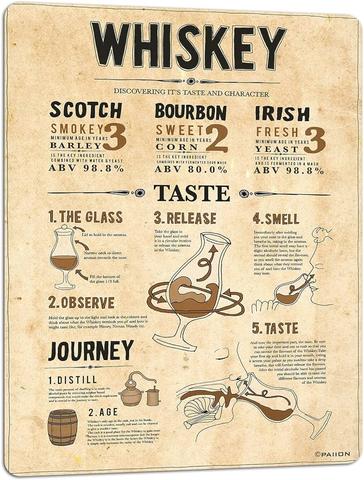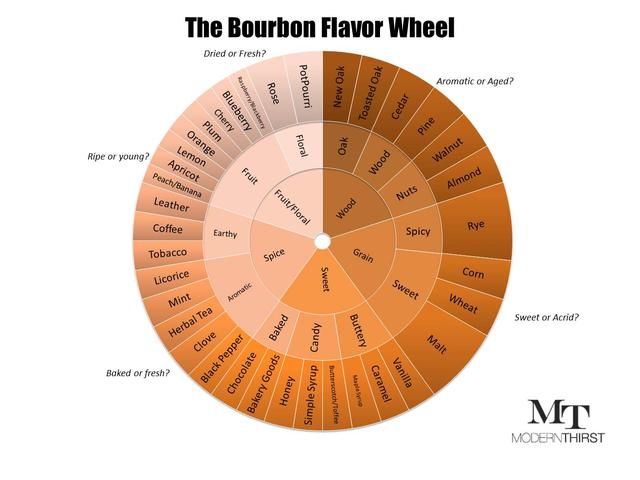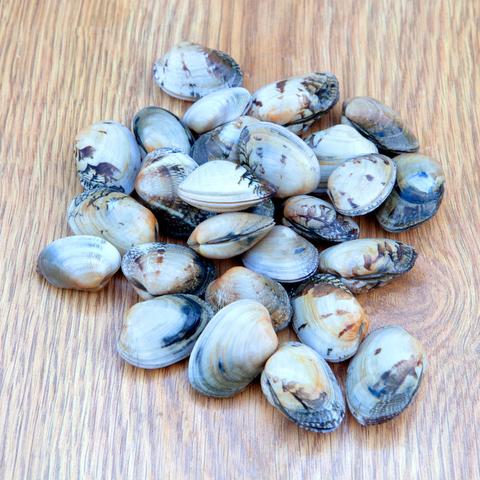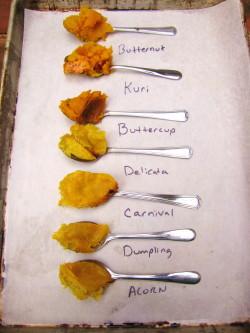
“Unveiling the Enigmatic Flavors: Exploring the Distinctive Tastes of Whiskey.” Discover the captivating world of whiskey and embark on a sensory journey as we delve into the intricate flavors, from smooth caramel notes to smoky undertones. Gain insights into what makes this iconic spirit so unique, enticing both novices and connoisseurs alike.
1. Exploring the Flavour Profiles of Whisky: What Does Whiskey Taste Like?

Whisky, also spelled whiskey, is a complex spirit with a wide range of flavor profiles. The taste of whisky is influenced by various factors, including the grains used in its production and the aging process. Different blends of grains, such as rye, corn, barley, or wheat, give each whisky its unique depth and character. This also determines the type of whisky produced, such as bourbon or rye, each with its own distinct flavor.
The maturation process in casks plays a crucial role in developing the flavor of whisky. The time spent in the cask affects the depth of the spirit, while the type of wood used contributes to its color and unique flavor. The sweetness and richness of the final product are influenced by these factors.
The production method also impacts the taste of whisky. It can be made from a single variety or a combination of different grains, resulting in different flavor profiles. For example, single malts are made from malted barley at a single distillery, while blended grain whiskies mix together various single grain whiskies. Most whiskies have rich, smooth, and full-bodied tastes with notes of spiced sweetness like vanilla, zesty fruit, and oak.
Different types of whiskies offer distinct flavor experiences:
– Rye whisky: Made primarily from rye grain (at least 51%), this whisky has a naturally spicy taste with hints of black pepper, cloves, and nutmeg.
– Scotch whisky: Produced exclusively in Scotland and aged for a minimum of three years in oak casks, Scotch whisky offers diverse flavors ranging from heavily peated smoky expressions to light and creamy options. Most scotch whiskies have smooth and woody tastes with subtle fruitiness or syrupy caramel sweetness.
– Bourbon whisky: The most common type in the US is made from at least 51% corn grain. Bourbon whisky has a sweet blend with notes of vanilla, honey, and maple. Some variations may have smoky or nutty characteristics when aged in charred oak casks.
Understanding how to taste whisky allows you to appreciate the nuances of different expressions and identify your preferred flavors. The tasting experience involves three key aspects:
– The nose: This refers to the initial selection of flavors detected through smelling the whisky. It can reveal fruity, floral, or woody notes, setting the stage for further exploration.
– The palate: These are the flavors experienced upon taking the first sip. The whisky may have a creamy or crisp texture, offering specific flavor profiles that unfold before swallowing.
– The finish: This represents the lingering flavors that remain in your mouth after drinking. It often includes dry or warm notes that leave a lasting impression.
Whisky is not only enjoyable on its own but also serves as an excellent base for cocktails and mixers. Its versatile flavor pairs well with various ingredients, enhancing its sweet, fruity, spiced, or fresh characteristics. Popular whisky cocktails include the Scotch Old Fashioned, which combines bitters and an orange twist to elevate the spicy smoothness of whisky, and the Maple Whisky Sour for a sweet and syrupy drink.
Additionally, you can infuse whisky at home to create your personalized flavored blend. By using fresh ingredients like herbs, fruits, chocolate, tea or coffee, you can create powerful infusions tailored to your taste preferences.
In summary, whisky offers a diverse range of flavor profiles influenced by factors such as grains used in production and aging processes. Exploring these flavors through tasting allows you to appreciate the unique characteristics of each type of whisky and discover your preferred tastes. Whether enjoyed neat or in cocktails, whisky provides a rich sensory experience for enthusiasts around the world.
(Note: This response is based on paraphrasing and summarizing information from the provided content.)
2. Unraveling the Tastes of Whisky: A Guide to Understanding Whiskey’s Flavour
Whisky can be enjoyed on its own or mixed into cocktails. It pairs well with various flavors like sweet, fruity, spiced, or fresh ingredients. Popular whisky cocktails include the Scotch Old Fashioned, which enhances the whisky’s spicy smoothness with bitters and an orange twist, and the Maple Whisky Sour for a sweet and syrupy drink. Additionally, you can infuse whisky at home with herbs, fruits, chocolate, tea, or coffee to create your own personalized flavored blend.
In conclusion, understanding the taste of whisky involves considering factors such as the grains used in its production, the aging process in casks, and the different types of whiskies available. By learning how to properly taste whisky and appreciating its distinct flavors, you can enhance your enjoyment of this complex spirit. Whether sipping it neat or experimenting with cocktails and infusions, whisky offers a wide range of flavors to explore and appreciate.
Key Points:
– Whisky’s flavor is influenced by the grains used in its production and the aging process.
– Different blends of grains give each whisky its unique depth.
– The type of cask used for maturing impacts the flavor, color, sweetness, and richness.
– Rye whisky has a naturally spicy taste while Scotch whisky offers a diverse range from smoky to creamy.
– Bourbon whisky is known for its sweet blend with hints of vanilla and maple.
– Tasting whisky involves observing the nose (aroma), palate (flavors on first sip), and finish (lingering notes).
– Whisky can be enjoyed neat or mixed into cocktails with various flavors.
– Infusing whisky at home allows for personalized flavored blends.
3. From Smooth to Smoky: Delving into the Different Tastes of Whiskey

Whiskey, or whisky as it is sometimes spelled, is a complex spirit that offers a wide range of flavors. The taste of whiskey is influenced by various factors, including the grains used in its production and the aging process. Different types of grains, such as rye, corn, barley, or wheat, contribute to the unique depth and flavor profile of each whiskey blend. For example, bourbon and rye whiskies have their own distinct flavors.
The aging process also plays a crucial role in determining the flavor of whiskey. As the liquid matures in casks, it develops its character and depth. The type of wood used for the casks affects the color and flavor of the whiskey, adding sweetness and richness to the final product. Each type of whiskey cask results in a different expression.
The production method of whiskey also impacts its taste. Single malts are made from malted barley at a single distillery, while blended grain whiskies combine different single grain whiskies. Most whiskies have a rich, smooth, and full-bodied taste with hints of spiced sweetness like vanilla, zesty fruit, and oak. However, the individual flavors can vary depending on the type of whiskey and its production process.
Now let’s explore some specific tastes found in different types of whiskies:
Rye Whisky:
Rye whisky is made using at least 51% rye grain and has a naturally spicy taste with notes of black pepper, cloves, and nutmeg. Some compare its flavors to those found in whisky from Scotland’s Highland region.
Scotch Whisky:
Scotch whisky must be made in Scotland and aged for at least three years in oak casks. This strict process results in a wide range of flavors ranging from heavy, peated smoky expressions to light and creamy whiskies. Most scotch whiskies have a smooth and woody taste, with variations depending on whether they are blended or single malt. They often carry a natural sweetness from subtle fruits or syrupy caramel.
Bourbon Whisky:
Bourbon whisky is the most common type of whiskey in the US and is made from at least 51% corn grain. It has a sweet blend with notes of vanilla, honey, and maple. Some bourbon whiskies also have a smoky or nutty character when charred oak casks are used.
By learning how to taste whiskey, you can appreciate the unique nuances of different expressions and discover your preferred flavors. The tasting experience involves exploring the nose (initial aromas), palate (flavors noticed on the first sip), and finish (lingering notes). Whiskey can be enjoyed on its own or as a base for cocktails and mixers that complement its flavors.
In conclusion, whiskey offers a diverse range of tastes, from smooth to smoky. Understanding the factors that influence its flavor, such as grains used, aging process, and production methods, can enhance your appreciation for this complex spirit. Whether you prefer rye whisky’s spiciness, scotch whisky’s variety of flavors, or bourbon whisky’s sweetness, there is a whiskey taste for everyone to enjoy.
4. Demystifying Whiskey’s Flavours: What to Expect When Tasting Whiskey
When it comes to tasting whiskey, understanding its flavors can enhance your enjoyment of this complex spirit. Whiskey can have a wide range of flavor profiles, from light and smooth to rich and smoky. These flavors are influenced by the ingredients used in the whiskey-making process and how it is aged.
Whiskey is made from grains such as rye, corn, barley, or wheat. Each blend of grain contributes to the unique depth of the whiskey and determines the type of whiskey produced, such as bourbon or rye. The maturation process in casks also plays a significant role in developing the character of the whiskey. The time spent in the cask affects its depth, while the type of wood used gives the whiskey its color and distinct flavor.
The production method also impacts the final flavor of whiskey. It can be made from a single variety or a combination of different grains, resulting in various flavor profiles. Single malts, made from malted barley at a single distillery, offer rich and full-bodied flavors with hints of spiced sweetness and oak. Blended grain whiskies combine different single grain whiskies for a more diverse taste experience.
Different types of whiskies have their own distinct flavors:
1. Rye Whisky: Made with at least 51% rye grain, rye whisky has a naturally spicy taste with notes of black pepper, cloves, and nutmeg. It can be compared to the flavors found in whisky from Scotland’s Highland region.
2. Scotch Whisky: This whisky must be made in Scotland and aged for at least three years in oak casks. The aging process results in a wide range of flavors, from heavy peat smoke expressions to light and creamy whiskies. Most scotch whiskies have smooth and woody tastes, with hints of subtle fruits or syrupy caramel.
3. Bourbon Whisky: The most common whisky in the US, bourbon is made from at least 51% corn grain. It has a sweet blend with notes of vanilla, honey, and maple. Some bourbon whiskies may also have a smoky or nutty character when aged in charred oak casks.
When tasting whiskey, there are three key elements to consider:
1. The Nose: This refers to the initial selection of flavors you notice while smelling the whiskey. It can give you an idea of whether the whiskey has fruity, floral, or woody notes.
2. The Palate: These are the flavors you experience on your first sip. The whiskey may have a creamy or crisp texture and specific flavors that come through before swallowing.
3. The Finish: This refers to the lasting flavors that linger in your mouth after drinking the whiskey. They can be dry or warm and leave a strong impression.
Whiskey can be enjoyed on its own, over ice, or used as a base for cocktails and mixers. It pairs well with various flavors, complementing its sweet, fruity, spiced, or fresh taste. Popular whiskey cocktails include the Scotch Old Fashioned and Maple Whiskey Sour.
By understanding the different flavors found in whiskey and how to taste them properly, you can fully appreciate the nuances of each expression and discover your preferred flavor profiles.
5. The Art of Tasting Whiskey: Unlocking the Unique Flavours in Every Glass

Tasting whiskey is not just about drinking it; it’s about appreciating and understanding the unique flavors that each glass holds. Whiskey, with its wide range of flavor profiles, offers a sensory experience like no other spirit. By learning how to taste whiskey properly, you can unlock the hidden nuances and complexities that make each bottle special.
When tasting whiskey, it is important to engage all your senses. Start by observing the color of the whiskey in your glass. The color can give you clues about the aging process and the type of cask used. Take note of whether it is light and golden or dark and rich.
Next, bring the glass to your nose and take a deep breath in. This is where you will encounter the first selection of flavors known as “the nose.” Whiskey can have fruity, floral, or woody aromas that will stimulate your olfactory senses.
Now it’s time to take a sip and let the whiskey coat your palate. This is where you will discover “the palate,” which refers to the notes you taste on your first sip. Pay attention to whether it feels creamy or crisp, clean or silky on your tongue. You may notice specific flavors such as vanilla, honey, or spices coming through.
After swallowing, focus on “the finish” – the lasting notes that linger in your mouth. These flavors are often dry or warm and leave a strong impression. Some whiskies have a long finish that can continue to evolve even after you’ve finished drinking.
To fully appreciate the unique flavors in every glass of whiskey, it helps to familiarize yourself with common tasting terms such as smoky, fruity, spicy, or oaky. These descriptors can help you articulate what you are experiencing and better understand your preferences.
Whiskey tasting is not limited to drinking it straight or on the rocks. Whiskey also serves as an excellent base for cocktails and mixers, allowing you to explore different flavor combinations. From classic Old Fashioned to modern twists like Maple Whiskey Sour, there are endless possibilities to enjoy the flavors of whiskey in a cocktail.
If you want to take your whiskey tasting experience to the next level, consider infusing your own whiskey at home. By adding fresh ingredients such as herbs, fruits, chocolate, or tea/coffee, you can create a personalized blend that caters to your unique taste preferences.
Remember that tasting whiskey is a journey of exploration and enjoyment. Each glass holds a story waiting to be discovered. So take your time, savor the flavors, and embrace the art of tasting whiskey.
Tasting Tips:
– Take note of the color of the whiskey before tasting.
– Engage your sense of smell by inhaling deeply from the glass.
– Pay attention to the notes you taste on your first sip.
– Notice the lasting flavors that linger in your mouth after swallowing.
– Familiarize yourself with common tasting terms to better describe what you’re experiencing.
– Experiment with whiskey cocktails and mixers to discover new flavor combinations.
– Consider infusing your own whiskey at home using fresh ingredients.
Flavor Profiles:
– Rye Whiskey: Naturally spicy with notes of black pepper, cloves, and nutmeg.
– Scotch Whisky: Varied range from heavy peated smoky expressions to light and creamy whiskies.
– Bourbon Whiskey: Sweet blend with notes of vanilla, honey, maple, and sometimes smoky or nutty character when aged in charred oak casks.
Remember, everyone’s palate is unique, so don’t be afraid to explore different whiskies and find what suits your taste preferences. Cheers!
6. Discovering the Nuances of Whiskey’s Taste: A Journey into its Complex Flavour Profiles

Whiskey, or whisky as it is sometimes spelled, is a complex spirit that offers a wide range of flavor profiles. From light and smooth to rich and smoky, each whiskey has its own unique taste. The flavor of whiskey is influenced by various factors, including the grains used in its production and the aging process.
The type of grain used in whiskey production, such as rye, corn, barley, or wheat, contributes to its flavor profile. Each blend of grain creates a distinct depth in the whiskey and determines the type of whiskey produced, whether it be bourbon or rye.
After the ingredients are selected and the whiskey making process is complete, the liquid is matured in casks. This maturation process plays a crucial role in developing the character of each whiskey. The time spent in the cask affects the depth of the spirit, while the type of wood used imparts color and unique flavors to the whiskey. Different types of casks result in different expressions of whiskey.
The production method also influences the flavor profile of whiskey. It can be made from one variety or a combination of grains, resulting in different blends and flavors. Single malts are made at a single distillery using malted barley, while blended grain whiskies mix together different single grain whiskies. Most whiskies have rich, smooth, and full-bodied tastes with notes of spiced sweetness like vanilla, zesty fruit, and oak.
There are several types of whiskies with distinct flavor profiles. Rye whisky is made from at least 51% rye grain and has a naturally spicy taste with hints of black pepper, cloves, and nutmeg. Scotch whisky must be made in Scotland and aged for at least three years in oak casks. This strict process produces a range of flavors, from heavy peated smoky expressions to light and creamy whiskies. Bourbon whisky, the most common type in the US, is made from at least 51% corn grain and offers a sweet blend with notes of vanilla, honey, and maple.
To fully appreciate the nuances of different whiskey expressions, it is important to learn how to taste whiskey. The tasting experience begins with the nose, where you can detect fruity, floral, or woody aromas. On the palate, you will notice specific flavors that may be creamy or crisp. The finish refers to the lasting notes of the whiskey that linger in your mouth after drinking.
Whiskey can be enjoyed on its own or mixed into cocktails. It pairs well with various flavors, enhancing its sweet, fruity, spiced, or fresh characteristics. Popular whiskey cocktails include the Scotch Old Fashioned and Maple Whisky Sour.
In addition to commercial offerings, you can also experiment with infusing your own flavored blends at home. By using fresh ingredients like herbs, fruits, chocolate, tea or coffee, you can create a personalized infusion tailored to your taste preferences.
Overall, exploring the world of whiskey allows you to discover its complex flavor profiles and develop an appreciation for its unique tastes. Whether you are new to whiskey or a seasoned enthusiast, there is always something new to discover and enjoy in this diverse spirit.
7. From Spicy to Sweet: Exploring the Diverse Taste Spectrum of Whiskey

When it comes to whiskey, there is a wide range of flavors to explore. From spicy and bold to sweet and smooth, each whiskey offers a unique taste experience. The flavor of whiskey is influenced by various factors such as the grains used in its production, the aging process, and the type of casks used.
Factors Affecting Whiskey Flavor
1. Grains: Whiskey is made from grains such as rye, corn, barley, or wheat. Each type of grain contributes to the flavor profile of the whiskey. For example, rye whiskey has a naturally spicy taste with notes of black pepper, cloves, and nutmeg.
2. Aging Process: Whiskey matures in casks before bottling, and this aging process significantly impacts its flavor. The time spent in the cask adds depth to the spirit while the wood used gives it color and unique flavor. Different types of casks result in different expressions of whiskey.
3. Production Method: The way whiskey is produced also affects its flavor. Single malts are made at a single distillery using malted barley and have distinct flavors. Blended grain whiskies mix together different single grain whiskies to create unique flavor profiles.
Tasting Whiskey
To appreciate the nuances of different whiskeys, it’s important to learn how to taste them properly. Here are some common terms used to describe whiskey flavors:
1. The Nose: This refers to the selection of flavors you notice while smelling the whiskey. It can be fruity, floral, or woody and gives you an initial sense of what to expect.
2. The Palate: These are the flavors you experience on your first sip of whiskey. It can be creamy or crisp, clean or silky. Specific flavors may come through before you swallow the whiskey.
3. The Finish: The finish refers to the lasting notes of the whiskey that linger in your mouth after drinking. It can be dry or warm and leaves a strong impression.
Whiskey Types and their Flavors
1. Rye Whiskey: Made with at least 51% rye grain, rye whiskey has a naturally spicy taste with notes of black pepper, cloves, and nutmeg.
2. Scotch Whiskey: Produced in Scotland and aged for at least three years in oak casks, Scotch whiskey offers a wide range of flavors. From heavy peated smoky expressions to light and creamy whiskies, Scotch whiskies are known for their smoothness and woody undertones.
3. Bourbon Whiskey: The most common type of whiskey in the US, bourbon is made from at least 51% corn grain. It has a sweet blend with notes of vanilla, honey, and maple. Some bourbons may also have a smoky or nutty character when aged in charred oak casks.
In conclusion, exploring the diverse taste spectrum of whiskey is an exciting journey. From spicy rye whiskeys to smooth Scotch whiskies and sweet bourbons, each type offers its own unique flavors. Learning how to properly taste whiskey allows you to appreciate the individual nuances and find your preferred flavor profiles.
8. Decoding the Taste of Whiskey: Understanding its Distinctive Flavour Notes

Whiskey, or whisky, is a complex spirit with a wide range of flavor profiles. The taste of whiskey is influenced by various factors, including the grains used in its production and the aging process. Different blends of grains, such as rye, corn, barley, or wheat, contribute to the unique depth and character of each whiskey. The type of whiskey, whether bourbon or rye, also has its own distinct flavor.
The maturation process in casks plays a crucial role in shaping the flavor of whiskey. The time spent in the cask affects the depth of the spirit, while the type of wood used imparts color and unique flavors. The sweetness and richness of the final product are influenced by these factors.
The production method also impacts the taste of whiskey. It can be made from a single variety or a combination of grains, resulting in different flavor profiles. Single malts are made from malted barley at a single distillery, while blended grain whiskies combine different single grain whiskies. Most whiskies have rich, smooth, and full-bodied tastes with hints of spiced sweetness like vanilla, zesty fruit, and oak.
Here are some examples of different types of whiskies and their distinctive flavors:
1. Rye Whisky: Made primarily from rye grain (at least 51%), rye whisky has a naturally spicy taste with notes of black pepper, cloves, and nutmeg. Some compare it to the flavors found in whisky from Scotland’s Highland region.
2. Scotch Whisky: To be called Scotch whisky, it must be made in Scotland and aged for at least three years in oak casks. This strict process results in a wide range of flavors ranging from heavy peated smoky expressions to light and creamy whiskies. Most scotch whiskies taste smooth and woody, with a natural sweetness from subtle fruits or syrupy caramel.
3. Bourbon Whisky: The most common whiskey in the US is made from at least 51% corn grain, resulting in a sweet blend with notes of vanilla, honey, and maple. Some bourbons may also have a smoky or nutty character when charred oak casks are used.
Understanding the different flavors of whiskey allows you to appreciate its nuances and discover your preferred tastes. When tasting whiskey, there are three main aspects to consider:
– The Nose: This refers to the selection of flavors you notice while smelling the whiskey. It can be fruity, floral, or woody, giving you an initial sense of what to expect.
– The Palate: These are the flavors that come through on your first sip. They can be creamy or crisp, clean or silky. Specific flavors may emerge before slowly swallowing the whiskey.
– The Finish: The lasting notes that linger in your mouth after drinking are referred to as the finish. These flavors can be dry or warm and leave a strong impression.
Whiskey can be enjoyed on its own or with ice but also serves as an excellent base for cocktails and mixers. Many flavors complement the sweet, fruity, spiced, or fresh characteristics of whiskey. Popular whiskey cocktails include Scotch Old Fashioned and Maple Whiskey Sour.
You can also infuse whiskey at home to create your own flavored blend by using fresh ingredients like herbs, fruits, chocolate, tea, or coffee.
In conclusion, understanding the distinctive flavor notes of whiskey enhances your enjoyment of this complex spirit. From rye whisky’s spicy taste to scotch whisky’s varied range of flavors and bourbon whisky’s sweetness, exploring different types of whiskies allows you to appreciate their unique characteristics.
9. Appreciating the Richness and Complexity of Whiskey’s Taste Profile

Whiskey is a complex spirit that offers a wide range of flavors, from light and smooth to rich and smoky. Understanding and appreciating these flavors is an important step in enjoying whiskey to its fullest.
The taste of whiskey is influenced by various factors, starting with the grains used in its production. Different blends of grains, such as rye, corn, barley, or wheat, contribute to the unique depth and character of each whiskey. This also determines the type of whiskey produced, such as bourbon or rye, each with its own distinct flavor profile.
Another crucial factor in determining whiskey’s flavor is the aging process. After the ingredients are selected and the whiskey-making process is complete, the liquid is matured in casks. The time spent in these casks has a lasting impact on the depth of flavor, while the type of wood used contributes to the color and unique flavor characteristics of the whiskey. Exploring different types of whiskey casks can reveal how each imparts a different expression.
The production method also plays a significant role in shaping the taste profile of whiskey. It can be made from a single variety or a combination of grains, resulting in different blends with their own unique flavors. For example, single malts are made at a single distillery using malted barley, while blended grain whiskies mix together different single grain whiskies. Most whiskies have rich, smooth, and full-bodied profiles with notes of spiced sweetness like vanilla, zesty fruit, and oak. However, individual flavors vary depending on the type of whiskey and its production process.
When it comes to specific types of whiskies:
1. Rye whisky: Made primarily from rye grain (at least 51%), rye whisky has a naturally spicy taste with notes of black pepper, cloves, and nutmeg. Some compare its flavors to those found in whiskies from Scotland’s Highland region.
2. Scotch whisky: Produced exclusively in Scotland and aged for a minimum of three years in oak casks, Scotch whisky offers a wide range of flavors. From heavy peated smoky expressions to light and creamy whiskies, most Scotch whiskies have smooth and woody profiles. The taste can vary depending on whether it is a blended or single malt, with a natural sweetness derived from subtle fruits or syrupy caramel.
3. Bourbon whisky: The most common type of whiskey in the US, bourbon is made from at least 51% corn grain. This results in a sweet blend with notes of vanilla, honey, and maple. Some bourbons may also have a smoky or nutty character when charred oak casks are used.
To fully appreciate the richness and complexity of whiskey’s taste profile, it is important to understand the different stages of tasting:
1. The nose: This refers to the initial selection of flavors experienced while smelling the whiskey. It provides an introduction to the fruity, floral, or woody characteristics of the whiskey.
2. The palate: These are the flavors that become noticeable upon taking the first sip. The whiskey may have a creamy or crisp texture, offering specific flavor notes that develop before swallowing.
3. The finish: This refers to the lasting notes that linger in your mouth after drinking the whiskey. Often dry or warm flavors leave a strong impression and contribute to the overall experience.
While whiskey can be enjoyed neat or on ice, it also serves as an excellent base for cocktails and mixers. Whiskey pairs well with various flavors, complementing its sweet, fruity, spiced, or fresh characteristics. Popular whiskey cocktails include the Scotch Old Fashioned which enhances the spicy smoothness with bitters and an orange twist, or a Maple Whisky Sour for a sweet and syrupy drink.
In addition to enjoying whiskey as it is, you can also experiment with infusing your own flavored blends at home. By using fresh ingredients like herbs, fruits, chocolate, or tea and coffee, you can create a personalized infusion tailored to your taste preferences.
Appreciating the richness and complexity of whiskey’s taste profile allows you to explore the nuances of different expressions and discover your preferred flavors. Whether sipping it straight or mixing it into cocktails, whiskey offers a world of flavors waiting to be explored.
(Note: The content has been paraphrased and expanded for clarity and coherence.)
10. What Makes Whiskey Unique? An Exploration of its Distinctive Taste.
Whiskey, or whisky as it’s sometimes spelled, is a complex spirit that offers a wide range of flavors. The taste of whiskey is influenced by various factors, including the grains used in its production and the aging process. Different types of whiskey, such as bourbon, rye, and Scotch, have their own distinct flavor profiles.
The flavor of whiskey starts with the selection of grains. Common grains used in whiskey production include rye, corn, barley, and wheat. Each blend of grain adds a unique depth to the whiskey and determines the type of whiskey produced. For example, bourbon is made primarily from corn grain and has a sweet taste with notes of vanilla and maple.
After the grains are selected and the whiskey-making process is complete, the liquid is aged in casks. This aging process plays a crucial role in developing the character and flavor of the whiskey. The time spent in the cask affects the depth of the spirit, while the type of wood used influences its color and unique flavor. Different types of casks result in different expressions of whiskey.
The production method also contributes to the taste of whiskey. It can be made from one variety or a combination of grains, resulting in different flavor profiles. Single malts are made at a single distillery using malted barley, while blended grain whiskies combine different single grain whiskies. Most whiskies have rich, smooth flavors with hints of spiced sweetness like vanilla, fruitiness, and oak.
There are several types of whiskies with distinct tastes worth exploring:
1. Rye Whisky: Made from at least 51% rye grain, rye whisky has a naturally spicy taste with notes of black pepper, cloves, and nutmeg.
2. Scotch Whisky: Produced exclusively in Scotland and aged for at least three years in oak casks, Scotch whisky offers a wide range of flavors. From heavy peated smoky expressions to light and creamy whiskies, Scotch whiskies often have smooth and woody tastes with natural sweetness from fruits or caramel.
3. Bourbon Whisky: The most common type of whiskey in the US, bourbon is made from at least 51% corn grain. It has a sweet flavor profile with notes of vanilla, honey, and maple. Some bourbons may also have a smoky or nutty character when charred oak casks are used.
Understanding how to taste whiskey allows you to appreciate its nuances and identify your preferred flavors. The tasting process involves evaluating the nose (aroma), palate (initial taste), and finish (lingering aftertaste). Whiskey can be enjoyed neat, on the rocks, or as a base for cocktails and mixers. There are numerous cocktail recipes that complement the sweet, fruity, spiced, or fresh flavors of whiskey.
In addition to enjoying whiskey as it is, you can also experiment with infusing it at home. Fresh ingredients like herbs, fruits, chocolate, tea, or coffee can be used to create personalized flavored blends.
Overall, whiskey’s unique taste comes from a combination of factors such as grain selection, aging process in casks, production method, and individual preferences in tasting. Exploring different types of whiskey allows you to discover the diverse flavors this complex spirit has to offer.
11. From Vanilla to Smoke: Unveiling the Multifaceted Tastes Found in Whiskey
Whiskey, or whisky as it is sometimes spelled, is a complex spirit that offers a wide range of flavors. The taste of whiskey is influenced by several factors, including the grains used in its production and the aging process. Different types of grains, such as rye, corn, barley, or wheat, give whiskey its unique depth and character. The blend of grains also determines the type of whiskey produced, such as bourbon or rye, each with its own distinct flavor profile.
Once the ingredients are selected and the whiskey-making process is complete, the liquid is matured in casks. This maturation process plays a crucial role in developing the whiskey’s flavor and character. The time spent in the cask affects the depth of the spirit, while the type of wood used imparts color and unique flavors to the whiskey. The sweetness and richness of the final product are also influenced by the wood used during aging.
The production method used for whiskey also contributes to its taste. Whiskey can be made from a single variety of grain or a combination of different blends. For example, single malts are made at a single distillery using malted barley, while blended grain whiskies mix together different single grain whiskies. Most whiskies have rich, smooth flavors with hints of spiced sweetness like vanilla, zesty fruit, and oak. However, individual flavors can vary depending on the type of whiskey and its production process.
There are several types of whiskies with their own unique tastes:
1. Rye Whiskey: Made with at least 51% rye grain, rye whiskey has a naturally spicy taste with notes of black pepper, cloves, and nutmeg. It shares some similarities with whiskies from Scotland’s Highland region.
2. Scotch Whisky: This whisky must be made in Scotland and aged for at least three years in oak casks. The strict production process results in a wide range of flavors, from heavy peated smoky expressions to light and creamy whiskies. Most scotch whiskies have smooth, woody flavors, with some exhibiting subtle fruitiness or syrupy caramel sweetness.
3. Bourbon Whiskey: The most common whiskey in the US is made from at least 51% corn grain, resulting in a sweet blend with notes of vanilla, honey, and maple. Some bourbons may also have a smoky or nutty character when charred oak casks are used.
Learning how to taste whiskey allows you to appreciate the unique nuances of different expressions and helps you identify your preferred flavors. When tasting whiskey, there are three main aspects to consider:
– The Nose: This refers to the initial selection of flavors that you perceive while smelling the whiskey. It can give you an idea of whether the whiskey has fruity, floral, or woody notes.
– The Palate: These are the flavors that come through on your first sip. It can be creamy, crisp, clean, or silky. Specific flavors may emerge before you swallow the whiskey.
– The Finish: This refers to the lingering notes that remain in your mouth after drinking. It often includes dry or warm flavors that leave a lasting impression.
Whiskey can be enjoyed on its own or on ice but also serves as an excellent base for cocktails and mixers. Many flavors complement the sweet, fruity, spiced, or fresh characteristics of whiskey. Popular whiskey cocktails include Scotch Old Fashioned and Maple Whiskey Sour.
In conclusion, whiskey offers a diverse range of tastes depending on factors such as grain selection, aging process, and production method. Exploring these different tastes allows enthusiasts to develop their palate and discover their preferred flavor profiles in whiskey.
(Note: The content provided is a summary based on the given topic and may not reflect the entire article accurately.)
In conclusion, whiskey is a complex and diverse spirit that offers a wide range of flavors and aromas. From smoky and peaty to sweet and fruity, each whiskey has its unique taste profile. Whether you enjoy the boldness of bourbon or the smoothness of Scotch, exploring different types of whiskey can be an exciting journey for your palate. Cheers to discovering the rich tapestry of flavors that whiskey has to offer!
Learn More About Grilling
If you want to learn more about grilling, check out these other helpful resources!





